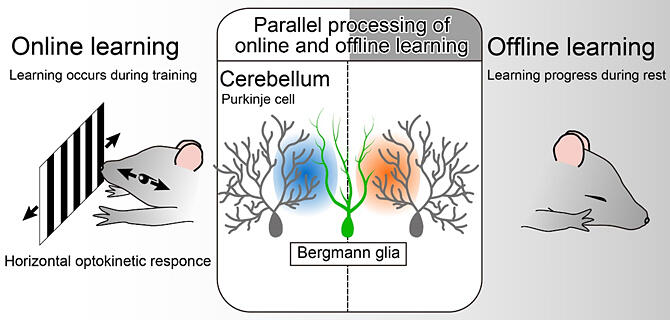There are two types of learning mechanisms: online and offline. Online learning induces immediate improvement during training, while offline learning results in slow and gradual improvements during breaks on the same day and toward the following day. To date, learning has been believed to continue during breaks as well. Moreover, offline learning is believed to continue if online learning is effective. Empirically speaking, however, even if students do not feel improvement during training, they may find that they understand the concepts on the following day. In contrast, the students may feel that they understand the concepts during training but then struggle with understanding them the next day.
Researcher Teppei Kanaya (at the time of research), Professor Ko Matsui, and their colleagues of the Graduate School of Life Sciences at Tohoku University used mice to investigate whether these two learning processes occurred independently or in parallel. The study was published in Glia.

Provided by Tohoku University
The researchers subjected the mice to horizontal optokinetic response (HOKR) training for 15 minutes. The mice were then given a one-hour break. The HOKR training was then performed again for one hour. The researchers found that the mice had unique characteristics. Immediately after the HOKR training, some showed good results in online training but were unable to show considerable improvements during offline learning, which they called the premature learning type. Others were not good at online learning but showed improvements in offline learning, which they called the late bloomer learning type.
Although the nerve cells process information, glial cells occupy almost the same volume in the brain, and the Bergmann glial cells in the cerebellum discharge glutamic acid via anion channels. The research revealed that offline learning after a training break progresses independently from achievements in online learning, while online learning is accelerated versus obstructed if the discharge of glutamic acid from the murine glial cells is promoted versus suppressed, respectively.
Matsui said, "I think that this research will lead to the development of some effective rehabilitation or other methods that recover learning function in cases of dementia by revealing the detailed mechanisms of online learning. In the future, we may be able to identify how to expand the brain of an animal or human being that will feature abilities that exceed the subject or patient's original abilities."
Journal Information
Publication: Glia
Title: Glial modulation of the parallel memory formation
DOI: 10.1002/glia.24431
This article has been translated by JST with permission from The Science News Ltd. (https://sci-news.co.jp/). Unauthorized reproduction of the article and photographs is prohibited.




